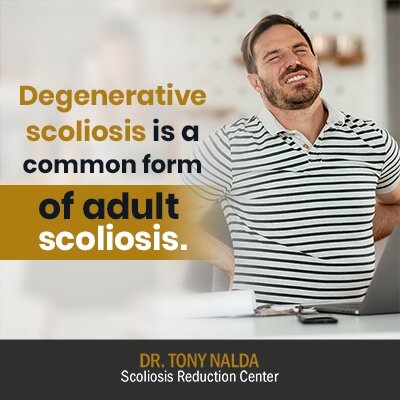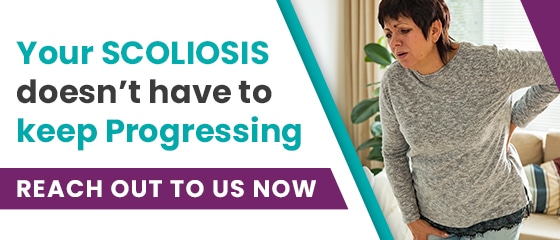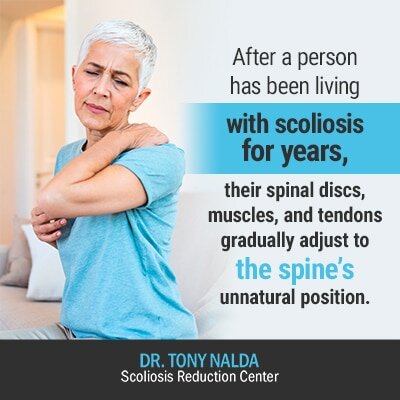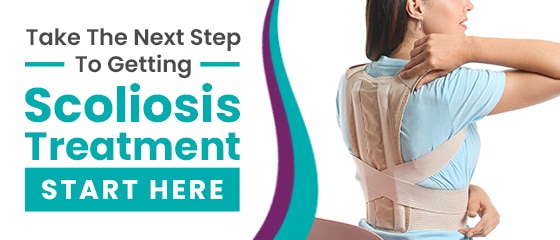How Do You Know if You Got Adult Scoliosis
While scoliosis is far more normally diagnosed in adolescence, adults can also develop the status and come to me for handling. Once skeletal maturity has been reached, the treatment focus shifts to reducing a curvature back to where it was before information technology started to produce noticeable symptoms, such as pain. Read on to find out how we accomplish this. While developed scoliosis can be managed through active treatment, no form of the status can be fully 'corrected', meaning 'cured'. This is because every bit a progressive and incurable condition, scoliosis is most guaranteed to become worse over time. While adult scoliosis can progress slowly, there is withal a cumulative effect, and this is why engaging in active treatment is then of import. Before nosotros move on to exploring the specifics of adult scoliosis in terms of treatment and symptoms, let's take a expect at where developed scoliosis fits in terms of condition course and prevalence. 1 of the reasons scoliosis is so often described as a circuitous condition is because it tin can develop at whatsoever age, and there are many different forms of the condition. It's besides circuitous to treat because there is no 1 handling plan that can exist applied to multiple patients; every instance is unique, which is why I accept never used the same treatment plan twice. Scoliosis can develop at any age; yet, the condition is most commonly diagnosed between the ages of 10 and 18. This grade of the condition is known as 'adolescent idiopathic scoliosis' and accounts for approximately 80 percent of known diagnosed cases. The 'idiopathic' designation refers to the condition's crusade, which is unknown. As this form has no known single cause, information technology'southward considered, instead, to be multifactorial, meaning it's onset is understood as a result of multiple factors that can differ from one person to the adjacent. I of the status'due south nomenclature points is cause, and the remaining 20 percent of diagnosed cases take known specific causes: built, neuromuscular, traumatic, and degenerative. Congenital scoliosis - congenital scoliosis develops due to a failure of the bones of the spine (vertebrae) to grade properly. Often, the spine'southward abnormal development occurs between week 8 and week 12 of gestation. If yous motion picture the vertebrae of the spine equally rectangular-shaped bricks stacked on top of i another, imagine what would happen if i of those bones was triangular in shape instead. That malformed vertebrae can cause the spine to sideslip out of alignment, throwing off the spine's biomechanics and leading to the development of scoliosis. Neuromuscular Scoliosis Neuromuscular scoliosis develops as a secondary complication of a more primary medical disease such every bit muscular dystrophy or cerebral palsy; these are diseases of the spine, muscular organization, and brain. Neuromuscular scoliosis is the second nearly common form of the condition. These diseases impair the body's ability to control movement via the muscles that support the spine, and this can lead to the development of scoliosis. These cases are among the well-nigh hard to treat considering there are two factors governing the condition: the neuromuscular disease and the progressive nature of scoliosis itself. When it comes to treatment, it'southward the primary neuromuscular disorder that has to be addressed first and foremost and will dictate the treatment approach. I tin can't requite these patients as positive prognoses as I can with more typical and treatable forms of the condition, only there is notwithstanding a lot we tin can do in terms of alleviating discomfort and helping these patients live their best lives. Traumatic Scoliosis Traumatic scoliosis can develop after the spine has sustained a trauma that has affected it adversely. Potential sources can be tumors, accidents, or other trunk traumas that impact the spine. Degenerative Scoliosis It develops out of the natural degenerative effects of aging that impact the spine, most notably the intervertebral discs. We will expand on this grade more than in a later department when nosotros move onto the specifics of adult scoliosis. For at present, nosotros have discussed the condition's most common form (AIS) and the departure between a condition classified as idiopathic, one considered as multifactorial, or having a known crusade. At present that we take a decent agreement of dissimilar condition forms and their prevalence, permit'due south movement on to early detection and diagnosis. If you lot have done your due diligence in researching scoliosis, it's likely you would have come across the of import benefits of early detection. This is because as a progressive condition, you desire to commencement active treatment as soon equally possible in the hopes of staying ahead of its natural progressive line. This is particularly important in the condition'south most common form, AIS, as early detection has a strong correlation to treatment success, but how does that cistron into adults with the condition? This leads usa directly into one of the condition'southward well-nigh complex characteristics: progression. I of the condition characteristics that factors into treatment arroyo most significantly is progression. In the status's most common form, AIS, progression guides the treatment approach because this age group is at the biggest chance of rapid progression. While we might non know the cause for this course, we do understand its progressive nature and how closely it's tied to growth and development. As adolescents, this historic period group is entering into the stage of puberty, marked by rapid and unpredictable growth spurts, so a large component of treatment is monitoring for growth and how the spine responds to that growth. When it comes to adult scoliosis, progression carries a different significance as having reached skeletal maturity, the risk factor of growth is removed. That being said, and this is of import to understand, progression is progression. Whether a condition progresses 10 degrees in two years, or over 12 years, if left untreated, the abnormal spinal curvature will still reach the aforementioned severity level; it just might have more time to get there. While scoliosis is frequently idea of as an boyish disorder, in that location has been a shift to exploring the prevalence of the condition in adults likewise. In fact, adolescent scoliosis rates sit at approximately ii to 4 percent, while the charge per unit of scoliosis in adults sits at between 12 and xx percent. While it'due south far more common to diagnose scoliosis in adolescents, it'due south clear that as the population ages, scoliosis rates increase. While progression becomes less of an immediate business organisation in the treatment of developed scoliosis, the actual number of scoliosis cases does increase with age. Now that we've determined that the prevalence of scoliosis increases with age, let'southward accept an in-depth look at the two main forms of adult scoliosis: developed idiopathic scoliosis, and adult degenerative scoliosis. Discussing adult idiopathic scoliosis brings us back to something nosotros've already touched on: early detection. This is because cases of adult idiopathic scoliosis are childhood cases that were undiagnosed. As touched on earlier, early on detection of scoliosis in adolescents is highly benign, but not e'er like shooting fish in a barrel to achieve. This is because having not yet reached skeletal maturity, adolescents don't more often than not find their status painful, and specially in milder forms of the status, even some of the postural changes it tin can produce are too subtle for an boilerplate person to notice. In many of these types of cases, patients went through adolescence unaware of their scoliosis, and it's not until reaching adulthood that they became aware something was wrong. When it comes to adult idiopathic scoliosis, it'due south pain that nigh oftentimes brings adults in to see me. This is considering a spine that is no longer growing is vulnerable to the compressive force of the curvature, and this affects the spine and its surrounding nerves, muscles, and tendons. This can present every bit back and/or neck pain, simply is often expressed equally radiating pain in the arms, legs, and feet due to pinched fretfulness. As scoliosis ranges in severity from balmy to moderate and severe, related symptoms can also change to reverberate the variance inside these classifications. Before we explore developed scoliosis treatment options, let's move on to the other common form of adult scoliosis which nosotros touched on earlier: degenerative scoliosis. Most common in adults over the age of 40, degenerative scoliosis occurs when the spine and its private parts start to feel the effects of years of article of clothing and tear. This is most commonly experienced by the intervertebral discs. Once the intervertebral discs start to degenerate, the spine can easily slip out of alignment. This is because the vertebrae of the spine are separated by the discs that act equally cushions so the bones don't grind upwardly against each other. If the discs commencement to deteriorate and are no longer giving support to the spine, this can speed up degenerative changes and lead to the spine slipping out of alignment and scoliosis developing. While the discs of the spine don't automatically degenerate with age, the cumulative result of lifestyle choices contribute to the health of the spine and its intervertebral discs. For example, choices such as sitting for long periods of time without good posture, not consuming enough water, leading an inactive life, or regularly lifting heavy objects improperly can lead to the cumulative consequence of spinal-disc degeneration. Other factors such as genetics tin can also play a function as some people's discs are better at property water, meaning they are less probable to deteriorate. Lack of move is a huge contributing cistron to an unhealthy spine. The very design of the spine is to facilitate movement, and it is through motion that the spinal discs can furnish their water level and stay salubrious. Activity also increases claret flow, meaning nutrients and moisture are more readily available to the discs; if action levels are low or nonexistent, the longevity of the discs is compromised, as is the overall wellness of the spine. In improver, people with degenerative scoliosis also often take osteoporosis; this commonly affects aging women facing changes to bone density associated with fluctuating hormone levels and menopause. When it comes to treating adult scoliosis, having reached skeletal maturity, at that place are not as many treatment options available every bit there are for children and adolescents. Notwithstanding, an adult with scoliosis nonetheless has options, and nonetheless has to make the important choice of how to manage and treat their status moving forward. When an adult comes in to see me here at the Scoliosis Reduction Heart, whether they already take a scoliosis diagnosis or not, function of my assessment is to discuss potential handling options moving forward. Here at the Center, nosotros want to treat the whole patient; this means taking into business relationship whatever and all areas of a patient'southward life affected by their condition, and treatment approach can profoundly bear upon daily life. As already mentioned, there are less handling options available to adults than adolescents, and this is because of a few factors. If you recollect of idiopathic scoliosis in adults, remember that these people take already been living with their status for years, prior to even finding out they accept scoliosis. Chances are, adults with idiopathic scoliosis who have simply learned they have scoliosis, are non in the early on stages of progression. Treating scoliosis simply becomes more challenging equally a condition progresses. Not only is this because the condition is naturally moving into its more severe phase of progression over time, merely besides because the trunk has had years to adjust to the abnormal spinal curvature. The body tin exist remarkably effective at adjusting to structural changes and compensating for these changes to preserve function. Also, keep in mind that as part of the key nervous organisation, the wellness of the spine impacts the brain. Just as the spine and closely-surrounding muscles and tendons can grow accustomed to the abnormal spinal curvature, then as well does the brain as it becomes comfortable with the patterns reinforcing the curvature. In addition, a spine that is no longer growing is less malleable and more rigid. Sometimes, in cases where the spine is particularly rigid, we first have to work towards restoring some spinal flexibility before we concentrate our efforts on an actual curvature reduction. Now that we've covered developed scoliosis in full general terms, let'south move on to treatment arroyo. As mentioned earlier, even though we are often dealing with developed patients who have already been progressing for years, or those dealing with degenerative scoliosis, deciding between the two main treatment approaches is all the same important. While in that location are obvious benefits to communicable a condition early on in its progressive line, it'south never too late to outset handling. When it comes to scoliosis treatment options, in that location are 2 main approaches patients have to make up one's mind between: traditional and functional. As the name suggests, 'traditional' has been effectually the longest, and the dominance of this approach is 1 of the factors that led to my condign a scoliosis specialist. I wanted to spread sensation of, in my stance, a ameliorate option. I wanted patients and their families to be enlightened that there are alternative handling options available: options that are more natural, less invasive, carry few, if any, side effects, and don't lead to irreversible spinal-fusion surgery. The traditional scoliosis handling arroyo is marked by watching and waiting. Fifty-fifty with adolescent forms, these patients are ofttimes told that if their condition is mild at the fourth dimension of diagnosis, the best recourse is to wait and observe to see if the condition really gets worse. The trouble with this is, as we have already discussed, as a progressive condition, scoliosis is virtually guaranteed to get worse, and whether it happens quickly or glacially, progression is, again, progression. In boyish idiopathic scoliosis, the only likely active treatment endeavor fabricated, prior to recommending surgery when a status progresses into that surgical threshold (40+ degrees), is bracing. While bracing can be an effective form of handling, for adults, this is less so equally their spine is no longer growing. In adults, if a caryatid is used as part of treatment, information technology's nigh often used to stabilize the spine and/or alleviate related pain and discomfort. So, if an adult with scoliosis is walking the traditional treatment path, they might be told to wear a brace, but more than likely, and peculiarly if their curvature has already progressed past 40 degrees, they will be told that spinal-fusion surgery is their best choice. This is where I want patients to really do their due diligence in researching the potential cost, side effects, and complications associated with spinal fusion. Once a spine is fused, in that location is no un-fusing it; still, if an adult was to come up into the Centre and choose our functional approach, if unhappy with treatment results, at that place is no impairment done. Our approach carries few, if any, side effects. Here at the Heart, we offer our patients an active and culling functional treatment arroyo. Our approach is integrative every bit patients benefit from the accessibility of multiple treatment disciplines all available under one roof. We want to address the underlying structural nature of the condition, which is why, first and foremost, we want to produce a structural change in the class of a curvature reduction. We exercise this past combining the merits of scoliosis-specific treatment disciplines such as targeted chiropractic adjustments, practice, therapy, and corrective bracing. While bracing doesn't take as potent a identify in our handling of adult scoliosis, our other disciplines work together to produce the all-time possible results. Frequently, the handling goal for adult scoliosis is to return the curvature to where it was before it started producing noticeable symptoms such as pain and postural changes; this helps to lessen/alleviate adverse symptoms by actively treating the underlying condition. In this way, we are working towards reducing the spine'due south aberrant curvature, plus related symptoms, by restoring as much of the spine's salubrious curves as possible. To conspicuously respond the question of if scoliosis can be corrected in adults and if there is nevertheless reason to hope: yes, active treatment tin can provide my developed patients with amazing results. That being said, there is no 'correcting' scoliosis; I say this because, most frequently, people acquaintance the term 'correction' with 'cure'. As explained before in the article, there is no cure for a progressive and incurable condition like scoliosis. The treatment goal is not to cure the condition, in the usual sense, but to instead command and manage its progression and related symptoms. Even once treatment has been accounted successful and a patient's degree of curvature has decreased, agile efforts have to be made to maintain that reduction. Scoliosis-specific exercise and stretches washed from home, plus in-office rehabilitation, therapy, and chiropractic intendance all work together to sustain those results once the intense handling phase is over. There is e'er hope for people with scoliosis of whatever historic period, and this is ane of the main points I piece of work towards getting across in Scoliosis Hope. While adults may not have the handling benefit of early on detection while the spine is still growing and flexible, there are still active forms of treatment that can lead to symptom-relief, a curvature reduction, and a significant improvement to every-day life. Dissimilar Forms of Scoliosis
Adolescent Idiopathic Scoliosis
Forms of Scoliosis with Directly Causes

Degenerative scoliosis is a mutual form of adult scoliosis.Scoliosis and Early Detection
Scoliosis and Progression

Prevalence of Adult Scoliosis
Adult Idiopathic Scoliosis
Adult Degenerative Scoliosis

Treating Adult Scoliosis

After a person has been living with scoliosis for years, their spinal discs, muscles, and tendons gradually adapt to the spine's unnatural position.Traditional vs Functional Treatment for Adult Scoliosis
Traditional Treatment and Developed Scoliosis
Functional Handling and Adult Scoliosis

Determination

Source: https://www.scoliosisreductioncenter.com/blog/can-scoliosis-be-corrected-in-adults
Postar um comentário for "How Do You Know if You Got Adult Scoliosis"